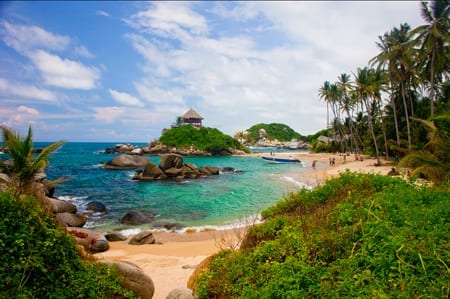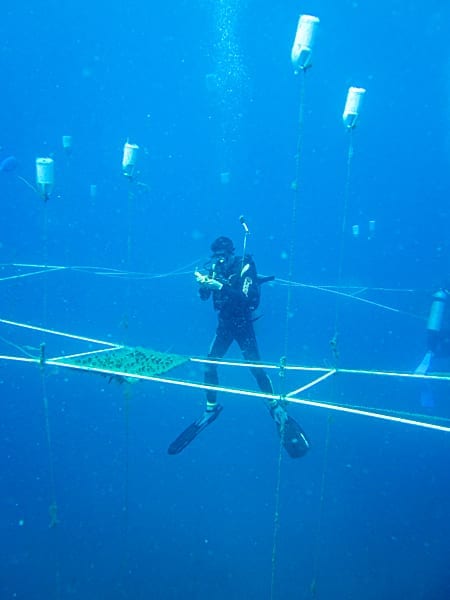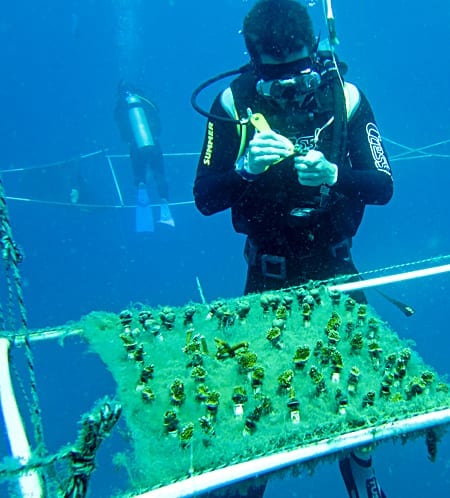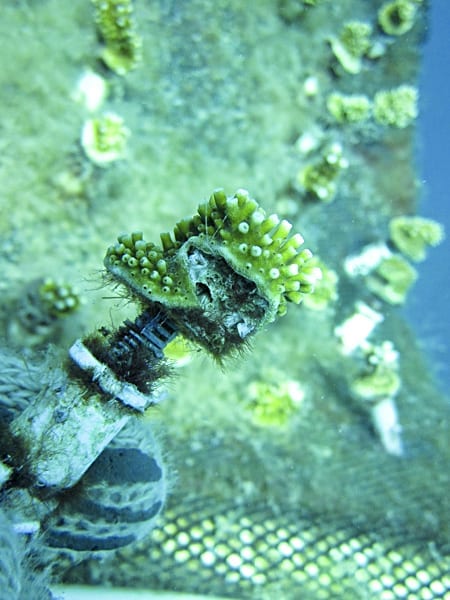By Daniel de la Calle
Right where you read these words now many others have stood, layer upon layer, in a frustrated attempt to write about corals and my dives at the Tayrona National Park back in June. They were not the problem, the source of trouble was the confusing mixture of sensations and thoughts I had while being underwater in that awe inspiring underworld of the Northern Colombian Coast. Remembering this morning the time I last visited my grandmother in Germany, soon before she died, I came to understand: I was very happy to get one more chance to see her again, to introduce her to my little daughter, but felt profoundly sad as well, overwhelmed with that “last time” feeling, with the apparent absurdity and purposelessness of a whole lifetime of acquired knowledge and experiences disappearing forever.

When I went down the wild cliffs and coves in Tayrona, while diving inside a giant cave or during the night immersions that revealed the true magic of polyp colonies, I went through the exact same emotions: immense gratitude to be there, to get to witness such an explosion of life, that display of shapes, of colors, such frenzy of activity, invisible and impossible to guess from the surface, but also abysmal sadness at the thought that the days of this whole ecosystem as it once was, even as it is now, are numbered; all this evolved primeval wisdom, this giant bank of results from trial and error over millions of years, this sophisticated network of lifeforms that carries on, unaware of their doomed future. I felt mostly guilty, but also greedy and dirty, knowing nothing other than the apparent needs of our generation is condemning our grandchildren to a world where tropical reefs will be talked about in the style of fairy tales, as a dream or a possible past. Swimming in Tayrona I was both the witness and perpetrator, the murderer staring amongst the crowd at the fallen body, hidden behind the safety and innocence of the masses. The thought of this disaster in slow motion tainted what would have otherwise been a marvelous diving experience; it was all too tragic, too surreal and beautiful to be enjoyed.
The group I dove with does very innovative work “farming” corals in a nursery. It is just the second or third location worldwide where such techniques are tried. They initially break off little pieces with polyps and glue them to small submerged farms that consist of buoys, ropes and plastic tubes.

A reduced group of specialists and scientists survey and clean on a weekly basis as they grow, hoping that after a year they will be ready to be implanted with epoxy glue back on the reef rocks. I was offered to trade a regular dive for a cleaning day at the farm and took the opportunity to appease the guilt and feel useful. It is always better to visit a place in the disguise of a worker rather than a plain tourist, to lend a hand in a project. The platform is in the middle of a small bay, levitating some 30 feet above the sand bottom and another 30 from the surface.

The only extra gear we wore were gloves, spatulas and some brushes to swipe the tubes clean from all the algae and barnacles that relentlessly menace with taking over. Barnacles are sharp as micro scalpels: you end up with dozens of invisible stinging cuts in fingers and palms no matter how careful you are. The whole place is in fact a testament to how fierce competition is underwater. To make things worse our poor corals are not exactly set with the best weapons and defense equipment. Algae, barnacles, muscles and other small crustaceans have the winning hand, and as temperatures go up and pH goes down corals become more and more brittle and defenseless. We, the untrained volunteers, focused exclusively on the cleaning of the tubes that conform the skeleton of the structure, while the scientists and initiated divers carefully brushed the fragile baby corals themselves.

Word that we were at work spread quickly throughout the bay; in a matter of minutes all kinds of fish swam around us to snack on the algae and barnacle dinner. Those fish became the only company as visibility progressively worsened. It is a strange sensation to focus on a task underwater, floating like an astronaut outside the space station; at a certain point you become totally disoriented, cannot quite discern what is up or down and begin to work as blind painter, reading the braille of detritus with the tips of your fingers, scrubbing away inside a dark green cloud. My mind spun around Cousteau, sushi, Gagarin, extraterrestrial life and also Penelope and Sisyphus, pondering on the futility of life, of repeated ant labor and the inventions of mankind. But it was knowing that these efforts take place while a bigger problem is bound to swallow all well meant smaller attempts that really sucked all the air from my soul. This was indeed a beautiful try, the portions of coral surprisingly looked like true baby life, very cute, the size of my daughter’s Calico Critters. I never thought something so small and rock-like looking could be so endearing.

The times I have delivered speeches, given interviews on behalf of Niijii Films or shown the film to groups a question tends to come out: “What have you accomplished so far? Has the film had any results in terms of policy changes, on people’s awareness and commitment?” Every single time I pause for a second in the hope of getting a lightning of inspiration that will put a better answer in my mouth, a more optimistic take on the whole matter. I begin to tell them about those few steps forward there have been so far, mention the Clean Water Act, all the research scientists are doing, the numerous screenings and festivals everywhere, the press, radio and tv, a meeting with the Minister for the Environment in some country, the handing of copies to decision makers worldwide, the increase of internet hits… Then I pause again and say: “Are you asking me if I believe there is hope? It depends on what you see as hope; not very much. But I do know that this that I am doing here is exactly what I should be doing.”
I am just scrubbing those tubes too.
————————————————————————————————————-
A LINK about redemption.


